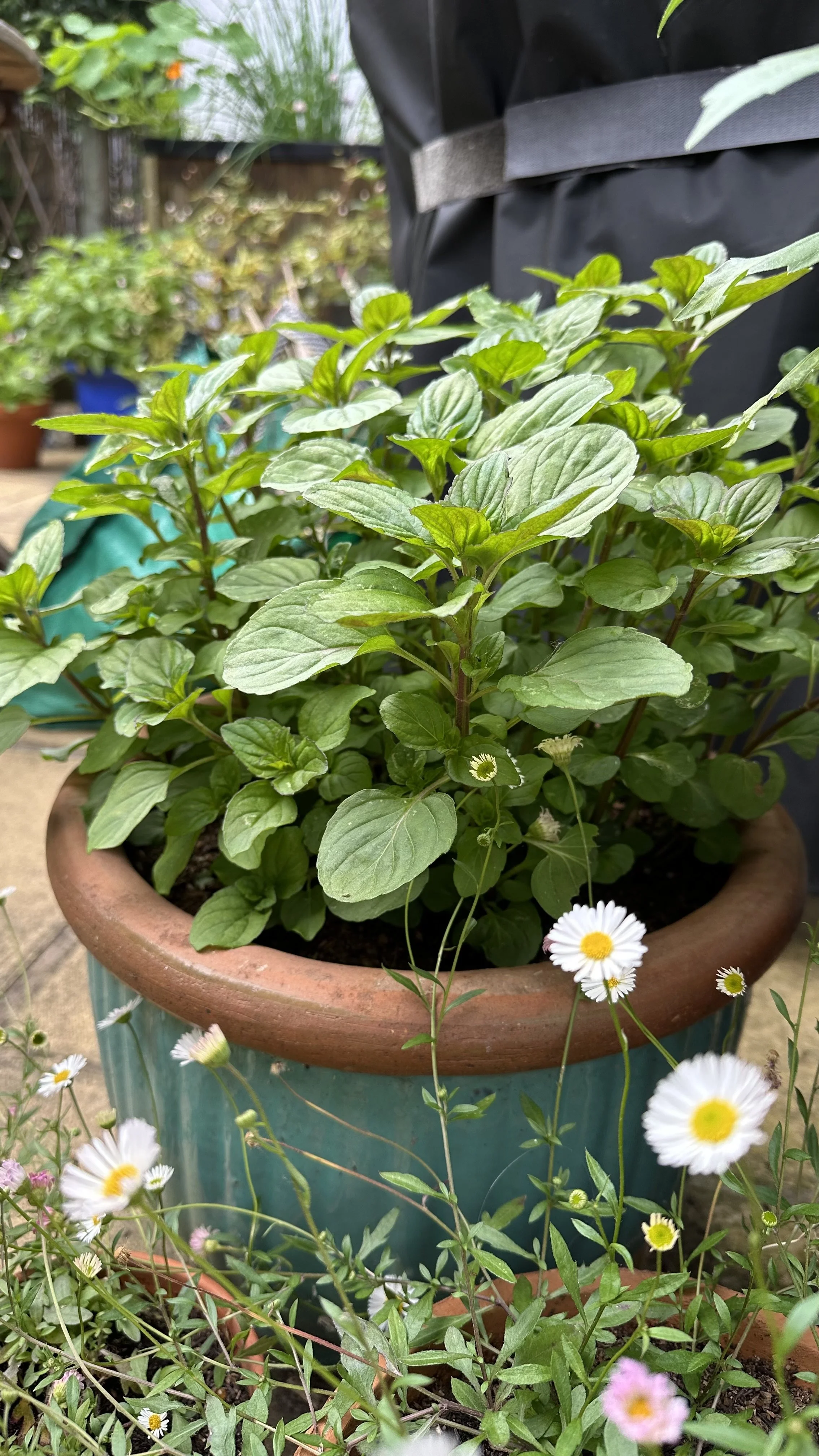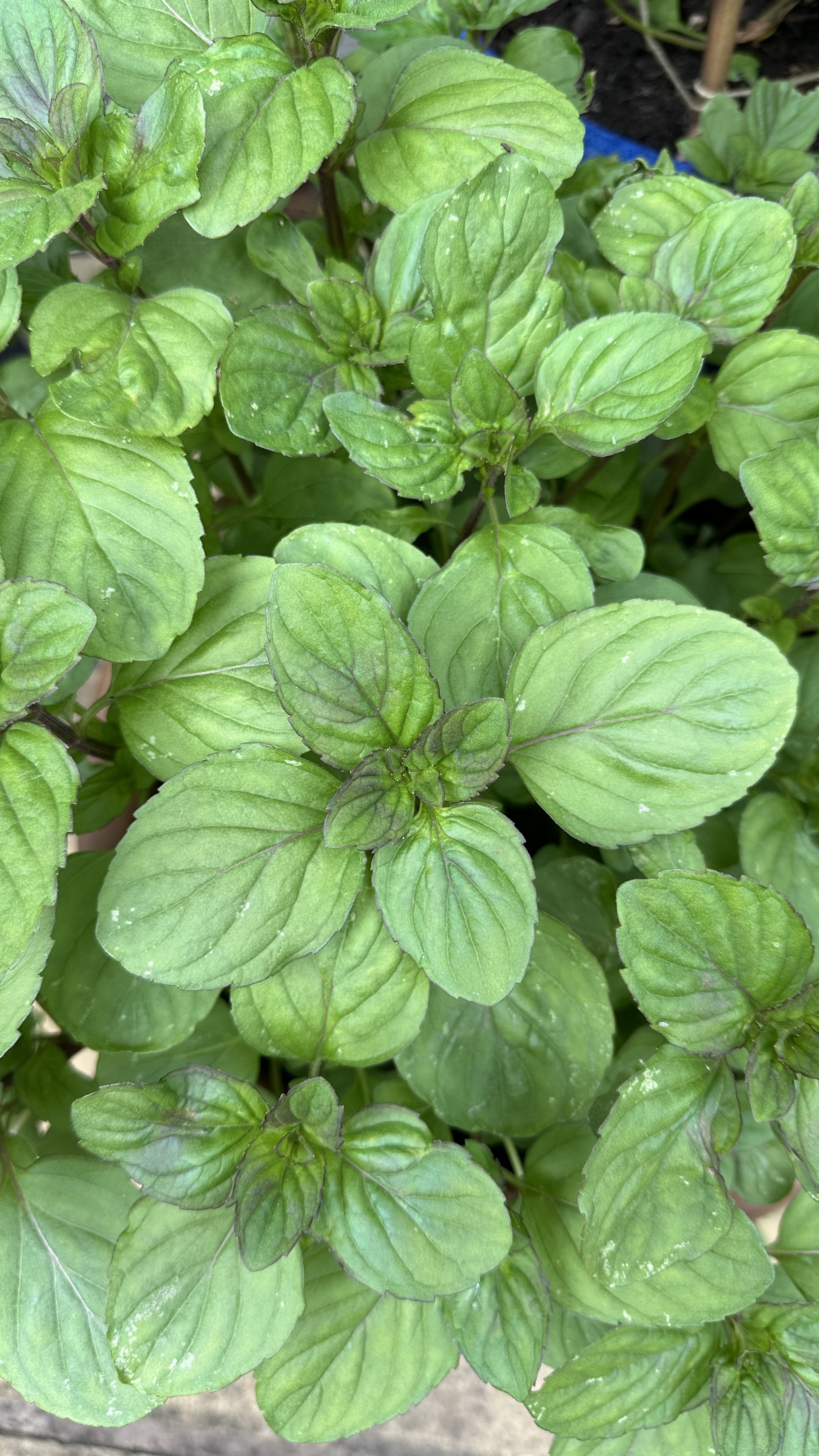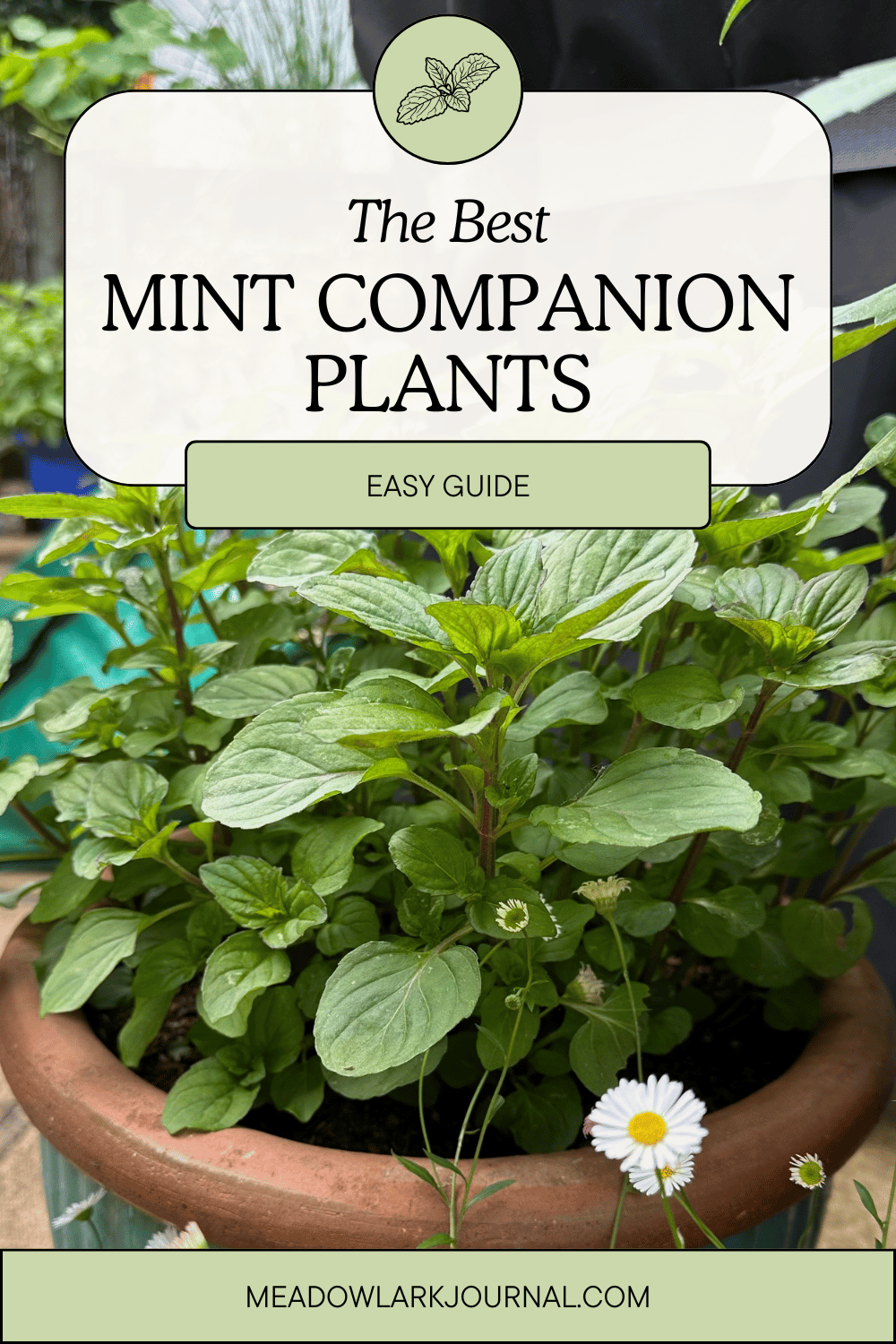Mint to Be Together: Choosing Companion Plants for Mint
This website is reader-supported - thank you! This post may contain affiliate links. As an Amazon Associate, I earn from qualifying purchases at no extra cost to you.
Here we dive into the world of mint companion plants.
The art of companion planting mint opens up tons of benefits for your garden.
This guide will take you through the harmonious relationships between mint and its best plant partners, highlighting the best choices and those to avoid.
We'll explore how the strategic pairing of mint with specific plants can lead to a thriving, healthy garden.
From selecting the right seeds to understanding the intricate dynamics of plants mint thrives alongside, get ready to enhance your garden's beauty and productivity with these insights into companion planting.
To learn more about growing mint, check out my guides:
Best Companion Plants for Mint
Mint is not just a standalone star in the garden; it's a team player.
Here are some of the best companions for mint, each with its unique benefits:
Rosemary and Mint: The Aromatic Duo
Why They Work Together:
Rosemary and mint both have strong scents that are great for repelling a variety of pests.
Planting them together creates an aromatic barrier that can protect more sensitive plants in your garden.
To learn more about growing rosemary, check out my guide How to Propagate Rosemary: A Step-by-Step Guide.
Benefits:
These herbs can help protect each other from common garden pests like aphids and enhance each other's growth.
Here is the rosemary I recommend growing:
Peppermint and Flowers: Beauty Meets Functionality
Ideal Floral Companions:
Flowers like marigolds and zinnias not only add splashes of color to your garden but also benefit from mint's pest repellent properties.
To learn more about growing zinnias, check out my guide How to Grow Zinnias in Pots: From Seed to Colorful Blooms.
Benefits:
Marigolds are known for their ability to deter nematodes and other pests, creating a mutually beneficial relationship with peppermint.
Here is the marigold variety I recommend growing:
Mint and Cabbage Family Vegetables: Guarding the Greens
Vegetable Allies:
Cabbage, broccoli, and cauliflower are excellent companions for mint.
The mint's scent deters cabbage moths and other insects that typically harm these vegetables.
Benefits:
This pairing helps in reducing the need for chemical pest control, leading to healthier, more natural vegetable growth.
Here is the cabbage I recommend growing:
Companion Plants with Mint in Herb Gardens: A Symphony of Scents
Herbal Companions:
Pairing mint with basil, oregano, and dill can create a robust herb garden.
These herbs enjoy similar growing conditions and can benefit from each other's presence.
To learn more about growing basil, check out my guide The Best Basil Companion Plants.
Benefits:
The combination of different scents can confuse pests, reducing damage to these herbs.
Plus, they make for a convenient herb collection for culinary use.
To learn more about herb gardening, check out my guide How to Start a Raised Bed Herb Garden.
Here is the basil I recommend growing:
Mint and Blueberry Companion Plants: Surprising Allies
Why It Works:
Mint can help deter insects that commonly plague blueberry bushes, like the blueberry maggot.
To learn more about growing blueberries, check out my guide Growing Blueberries in Containers Simplified.
Benefits:
This companionship ensures healthier blueberry plants with potentially higher yields, without the need for harsh pesticides.
Here is the blueberry plant I recommend growing:
A Note on Mint's Vigorous Growth:
While mint is a great companion, it's important to remember its invasive nature.
Mint can quickly overtake other plants if not properly managed.
Consider planting mint in a separate pot or a contained area to prevent it from spreading uncontrollably.
Want to learn more about herb gardening?
Check out my guides:
Lime mint.
To learn more about starting an herb garden, check out my guide:
What Not to Plant with Mint
While mint is a friendly companion to many plants, it's not a perfect match for all.
Here are some plants you might want to think twice about before planting them near your mint:
Parsley: The Sensitive Neighbor
Why They Clash:
Parsley and mint have contrasting growth habits and needs.
Mint's aggressive growth can quickly overshadow the more delicate parsley, hindering its growth.
Considerations:
If you love both herbs, it's best to keep them in separate areas of your garden or in different containers to ensure they both have enough space and resources to thrive.
To learn more about growing parsley, check out my guide Parsley's Perfect Partners: Companion Planting for Parsley.
Chamomile: The Fragile Friend
Why They're Incompatible:
Chamomile is another plant that can suffer from mint's invasive nature. Mint may encroach on chamomile's space, affecting its ability to grow and flourish.
Tip:
Like parsley, chamomile is best grown in a different location from mint to ensure it receives adequate sunlight and soil nutrients.
To learn more about growing chamomile, check out my guide Harvesting Chamomile: From Garden to Teacup.
Other Invasive Herbs: A Battle for Dominance
Examples:
Herbs like lemon balm or other varieties of mint can compete fiercely with each other for space and nutrients, leading to a struggle where none of the plants may thrive optimally.
Strategy:
If you're keen on growing various invasive herbs, consider using separate containers or clearly defined garden beds to maintain harmony in your garden.
Slower Growing, Delicate Plants: The Overwhelmed Companions
Any plant that grows slower or is more delicate in structure might find it challenging to compete with mint's vigorous growth habit.
Evaluate the growth speed and space requirements of other plants in your garden.
If they're on the slower or more delicate side, it's best to plant them away from mint.
Managing Mint's Growth:
Remember, the key to successfully incorporating mint into your garden without negatively impacting other plants lies in managing its growth.
Regular pruning and containing its roots (by planting in pots or designated areas) can prevent mint from becoming an unwelcome neighbor in your garden.
While mint is a wonderful addition to any garden, it's crucial to be mindful of its nature and the impact it can have on certain plants.
By choosing the right companions and providing adequate space and care, you can enjoy the benefits of mint without compromising the health and beauty of your other beloved plants.
Expand your herb garden with easy propagation.
Check out my guides to learn how:
Special Considerations for Indoor and Container Gardening
Growing mint and its companions indoors or in containers comes with its own set of challenges.
Here's how to make the most of your mint companion planting in these settings:
Container Size and Spacing:
Mint is a vigorous grower, even in containers.
Choose a large enough container to accommodate its growth while ensuring adequate space for its companion plants.
Tip:
If pairing mint with other herbs or small plants, consider using a wide, shallow container that allows each plant enough room to spread its roots without overcrowding.
Here is the container I recommend for growing mint:
Equip your urban green space with my recommend top tier tools.
Soil and Watering Requirements:
Watering Tips:
Mint likes moist soil but dislikes waterlogging. Ensure your container has good drainage and water your plants when the top inch of soil feels dry.
For more watering tips, check out my guide How to Use Watering Globes.
Soil Considerations:
Both mint and its companions will thrive in well-draining, nutrient-rich soil.
Regular potting mix with added compost works well.
Check out my guide Does Potting Soil Go Bad? Know the Warning Signs.
Here is the potting mix I recommend for mint:
Light and Temperature:
Sunlight Needs:
Mint and many of its companions require plenty of sunlight.
Place your container in a spot that receives at least 4-6 hours of sunlight daily like a south-facing or west-facing garden location.
Temperature Management:
Keep your container in a location with a consistent, moderate temperature.
Avoid placing it near heat sources or in drafty areas.
Choosing the Right Companions:
For Limited Spaces:
Opt for compact companions like smaller herbs (basil, oregano) or flowers (marigolds, pansies) that won't be overwhelmed by mint.
Indoor Companions:
Consider the plant's needs and habits. Some plants may require more or less light and water than mint, which can be a challenge in a shared container.
Managing Mint's Spread:
Containment Strategies:
To prevent mint from taking over, consider planting it in its own pot and then placing this pot within a larger container alongside other plants.
This "double potting" method helps control mint's growth.
Pruning Regularly:
Regular trimming of mint will not only keep it from overgrowing but also encourage fuller, bushier growth.
Health and Maintenance:
Regular Check-ups:
Keep an eye on your plants for signs of stress, pests, or disease.
Container plants can be more susceptible to issues due to limited growing space.
Feeding Your Plants:
Use a balanced, all-purpose liquid fertilizer every few weeks during the growing season to ensure all plants in the container are getting the nutrients they need.
Here is the fertilizer I recommend:
For more herb growing tips, check out my guide:
Caring for Your Mint Companion Garden
Creating a companion garden with mint is just the beginning.
To ensure your mint and its companions flourish, here are some key care tips:
Soil Health:
Quality Soil:
Start with a well-draining soil rich in organic matter. Mint thrives in slightly acidic to neutral soil (pH 6.0 to 7.0).
Mulching:
Applying a layer of organic mulch helps retain soil moisture and reduces weed growth.
This is particularly beneficial for mint and its companions, as it keeps the soil cool and moist.
Check out my guide The Best Alternatives to Traditional Mulch for Your Garden.
Watering Wisely:
Consistent Moisture:
Mint prefers consistently moist soil but can suffer in waterlogged conditions.
Water your plants when the top inch of soil feels dry to the touch. This is a great way to use water collected from a water butt.
To learn more about water butts, check out my guide Water Butts: Sustainable Water Storage for Your Garden.
Method:
Use a watering can or a gentle spray to water at the base of the plants.
Avoid overhead watering to reduce the risk of fungal diseases.
Pruning and Harvesting:
Regular Pruning:
Keep your mint plants bushy and productive by regularly pinching off the tips.
This encourages lateral growth and prevents legginess.
Harvesting Technique:
Harvest mint leaves as needed, preferably in the morning when their essential oils are strongest.
Be careful not to over-harvest, which can weaken the plant.
Pest and Disease Management:
Regular Monitoring:
Keep an eye out for common pests like aphids and spider mites.
While mint is a natural pest repellent, it's not immune to infestations.
Natural Solutions:
Use organic pest control methods like neem oil or insecticidal soap for managing small pest problems.
Encouraging beneficial insects, such as ladybugs, can also help control pests.
Companion-Specific Care:
Individual Needs:
Remember that each plant in your companion garden has unique needs.
Ensure each plant's specific requirements for water, light, and nutrients are met.
Spatial Arrangement:
Arrange your plants so that taller companions don't overshadow smaller ones, ensuring equal access to sunlight.
Check out my guide:
Why Choose Companion Plants for Mint
Mint is a versatile and robust herb, playing a pivotal role in the garden.
But why pair it with other plants?
Pest Repellent Powerhouse:
Mint is a natural pest repellent.
Its strong scent is a formidable foe against common garden pests like aphids, spider mites, and even rodents.
When planted alongside vulnerable plants, mint acts as a protective guardian, warding off unwanted critters without the need for chemical pesticides.
Attracting Beneficial Insects:
While keeping the bad guys out, mint also plays the role of a charismatic host, attracting beneficial insects.
These include pollinators like bees and butterflies, which are crucial for a healthy and thriving garden.
Additionally, mint attracts predatory insects that feed on common pests, aiding in natural pest control.
Soil Health and Growth Harmony:
Mint helps maintain soil health by keeping it moist and well-aerated.
Its extensive root system is great for breaking up compact soil, which can benefit neighboring plants.
Plus, mint's rapid growth can provide ground cover, reducing weeds and maintaining soil moisture.
Spatial Efficiency:
Mint, known for its tendency to spread, can be kept in check through companion planting.
By pairing it with plants that require similar growing conditions but occupy different spatial niches (like taller plants or root vegetables), you maximize the use of garden space and create a harmonious growing environment.
Aesthetic Appeal:
Beyond practical benefits, there's an aesthetic aspect to consider.
Mint, with its lush greenery and occasional delicate flowers, adds beauty and variety to any garden.
It can turn a mono-crop garden into a vibrant tapestry of colors and textures.
Herbal Companionship:
In herb gardens, mint can be a great companion to many herbs. Its presence can deter pests that might otherwise harm more sensitive herbs.
Plus, having a variety of herbs in close proximity can make for convenient harvesting for culinary uses.
To learn more about herb gardening, check out my guide How to Start a Raised Bed Herb Garden.
By integrating mint into your garden through thoughtful companion planting, you're not just planting an herb; you're cultivating a miniature ecosystem that's resilient, productive, and beautiful.
This approach embodies a synergy where each plant contributes to and benefits from the other, exemplifying the essence of a thriving garden.
FAQs
Can mint kill other plants?
Mint itself doesn't kill other plants, but its aggressive growth can overwhelm and overshadow nearby plants, especially those that are less competitive or slower growing.
This can lead to these plants receiving less light, space, and nutrients, potentially stunting their growth or causing them to die indirectly.
To prevent this, plant mint in a confined space or in a pot, even when planted in a garden bed, to control its spread.
What are some good mint companion plants for indoors?
Indoors, mint can be paired with a variety of herbs that have similar light and water requirements.
Good companions include basil, oregano, and thyme.
These herbs can benefit from mint's pest-repellent properties and can be grown together in a large container or adjacent pots.
Make sure they're placed in a sunny spot and are watered regularly for optimal growth.
Pin this post to save it for later!











































